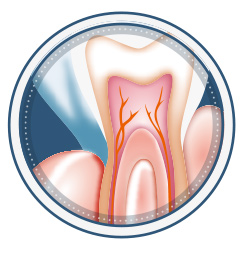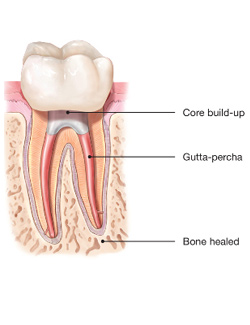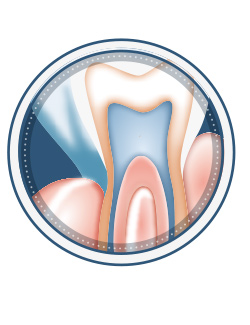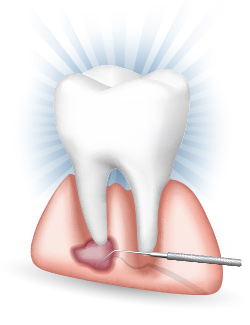Endodontic Treatment
Our Primary Objective is Saving Your Teeth
The Treatments & Procedures that Enable Us to Successfully Care for You
If you have a diseased or injured tooth, it’s important to know and understand your treatment options. Patients today have more options than ever before to treat their teeth. Understanding your choices and their impact on your future dental health and lifestyle is important.
Your dentist will advise you of proposed treatment and any reasonable alternatives, so you can make a fully informed decision about your dental care. This may include a referral to or consultation with a dental specialist, such as an endodontist, to explore all treatment options.

Types of Endodontic Treatment
Regardless of the cause of your current situation, in the majority of cases, your tooth can be saved with endodontic treatment.
While endodontists are specialists in saving teeth—meaning they are trained in performing root canals and other endodontic procedures to save the tooth— they will look at all treatment options to determine the best for each individual patient and case.
- Root canal treatment
- Endodontic retreatment
- Endodontic Microsurgery
- Internal Bleeching
Root Canal Treatment


If you have recently learned or have been diagnosed with symptoms that require a root canal , you’re not alone. Millions of teeth are treated and saved each year with root canal, or endodontic, treatment.
It is important to remember that root canal treatment doesn’t cause pain, it relieves it.
Inside the tooth, under the white enamel and a hard layer called the dentin, is a soft tissue called the pulp. The pulp contains blood vessels, nerves and connective tissue, and helps to grow the root of your tooth during development. In a fully developed tooth, the tooth can survive without the pulp because the tooth continues to be nourished by the tissues surrounding it.
Modern root canal therapy is very similar to having a routine filling and usually can be completed in one or two appointments, depending on the condition of your tooth and your personal circumstances. When you entrust Micro Endodontics, you are assured a comfortable experience during and after your appointment.
Saving the natural tooth with root canal treatment has many advantages:
- Efficient chewing
- Normal biting force and sensation
- Natural appearance
- Protects other teeth from excessive wear or strain
Retreatment Therapy

With proper care, even teeth that have had root canal treatment can last a lifetime. But sometimes, a tooth that has been treated doesn’t heal properly and can become painful or diseased months or even years after treatment. If your tooth failed to heal or develops new problems, you have a second chance. An additional procedure may be able to support healing and save your tooth.
If you are experiencing dental pain or discomfort in a previously treated tooth, talk to an endodontist about retreatment.
As occasionally happens with any dental or medical procedure, a tooth may not heal as expected after initial treatment for a variety of reasons:
- Narrow or curved canals were not treated during the initial procedure.
- Complicated canal anatomy went undetected in the first procedure.
- The placement of the crown or other restoration was delayed following the endodontic treatment.
- The restoration did not prevent salivary contamination to the inside of the tooth.
In other cases, a new problem can jeopardize a tooth that was successfully treated. For example:
- New decay can expose the root canal filling material to bacteria, causing a new infection in the tooth.
- A loose, cracked or broken crown or filling can expose the tooth to new infection.
- A tooth sustains a fracture.
During retreatment, the endodontist will reopen your tooth and remove the filling materials that were placed in the root canals during the first procedure. The endodontist then carefully examines the tooth, looking for additional canals or new infection. The endodontist then removes any infection, cleans and shapes the canals, and places new filling materials. The opening is then sealed with a temporary filling. Once the tooth heals, a new crown or other restoration is placed on the tooth to protect it.
Endodontic Microsurgery

Occasionally, a nonsurgical root canal procedure alone cannot save your tooth and your endodontist will recommend surgery. Endodontic surgery can be used to locate small fractures or hidden canals that weren’t detected on x-rays or during previous treatment. Surgery may also be needed to remove calcium deposits in root canals, or to treat damaged root surfaces or the surrounding bone of the tooth.
Endodontists use advanced technologies like digital imaging and operating microscopes to perform surgeries quickly, comfortably and successfully.
There are many surgical procedures that can be performed to save a tooth. The most common is called an apicoectomy, or root-end resection, which is occasionally needed when inflammation or infection persists in the bony area around the end of your tooth after a root canal procedure. In this microsurgical procedure, the endodontist opens the gum tissue near the tooth to see the underlying bone and to remove any inflamed or infected tissue. The very end of the root is also removed. A small filling may be placed to seal the end of the root canal and few stitches or sutures are placed to help the tissue heal. Over a period of months, the bone heals around the end of the root. Local anesthetics make the procedure comfortable, and most patients return to their normal activities the next day. Postsurgical discomfort is generally mild.






